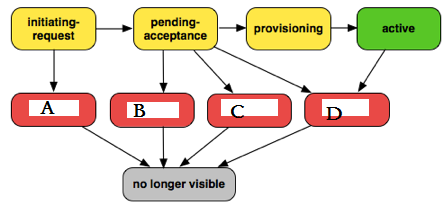Oracle Advanced SQL and PL/SQL Developer Certification Questions and Answers (Dumps and Practice Questions)
Question : Which of these set operators will not sort the rows?

1. INTERSECT
2. MINUS
3. Access Mostly Uused Products by 50000+ Subscribers
4. UNION ALL
Correct Answer : Get Lastest Questions and Answer :
Question : Select the correct statement which applies to single-row functions?

1. It will always retun value else error
2. It will be executed for each record
3. Access Mostly Uused Products by 50000+ Subscribers
4. All of the above
Correct Answer : Get Lastest Questions and Answer :
Exp: Single row functions can be character functions, numeric functions, date functions, and conversion functions. Note that these functions are used to manipulate data items. These functions require one or more input arguments and operate on each row, thereby returning one output value for each row. Argument can be a column, literal or an expression. Single row functions can be used in SELECT statement, WHERE and ORDER BY clause. Single row functions can be - General functions - Usually contains NULL handling functions. The functions under the category are NVL, NVL2, NULLIF, COALESCE, CASE, DECODE. Case Conversion functions - Accepts character input and returns a character value. Functions under the category are UPPER, LOWER and INITCAP. UPPER function converts a string to upper case. LOWER function converts a string to lower case. INITCAP function converts only the initial alphabets of a string to upper case. Character functions - Accepts character input and returns number or character value. Functions under the category are CONCAT, LENGTH, SUBSTR, INSTR, LPAD, RPAD, TRIM and REPLACE.
CONCAT function concatenates two string values. LENGTH function returns the length of the input string. SUBSTR function returns a portion of a string from a given start point to an end point. INSTR function returns numeric position of a character or a string in a given string. LPAD and RPAD functions pad the given string upto a specific length with a given character. TRIM function trims the string input from the start or end. REPLACE function replaces characters from the input string with a given character. Date functions - Date arithmetic operations return date or numeric values. Functions under the category are MONTHS_BETWEEN, ADD_MONTHS, NEXT_DAY, LAST_DAY, ROUND and TRUNC. MONTHS_BETWEEN function returns the count of months between the two dates. ADD_MONTHS function add 'n' number of months to an input date. NEXT_DAY function returns the next day of the date specified. LAST_DAY function returns last day of the month of the input date. ROUND and TRUNC functions are used to round and truncates the date value. Number functions - Accepts numeric input and returns numeric values. Functions under the category are ROUND, TRUNC, and MOD. ROUND and TRUNC functions are used to round and truncate the number value. MOD is used to return the remainder of the division operation between two numbers.
Question : Select the function which could do case conversion on latter

1. SMALLER
2. INITCASE
3. Access Mostly Uused Products by 50000+ Subscribers
4. All of the above
Correct Answer : Get Lastest Questions and Answer :
Exp: his Oracle tutorial explains how to use the Oracle/PLSQL INITCAP function with syntax and examples.
DESCRIPTION
The Oracle/PLSQL INITCAP function sets the first character in each word to uppercase and the rest to lowercase.
SYNTAX
The syntax for the Oracle/PLSQL INITCAP function is:
INITCAP( string1 )
Parameters or Arguments
string1 is the string argument whose first character in each word will be converted to uppercase and all remaining characters converted to lowercase.
APPLIES TO
The INITCAP function can be used in the following versions of Oracle/PLSQL:
Oracle 12c, Oracle 11g, Oracle 10g, Oracle 9i, Oracle 8i
EXAMPLE
Let's look at some Oracle INITCAP function examples and explore how to use the INITCAP function in Oracle/PLSQL.
For example:
INITCAP('tech on the net');
Result: 'Tech On The Net'
INITCAP('GEORGE BURNS');
Result: 'George Burns'
Related Questions
Question : You want to display percent of the employees with the highest salaries in the EMPLOYEES
table. Which query will generate the required result?

1. A
2. B
3. Access Mostly Uused Products by 50000+ Subscribers
4. D
Question : In the customers table, the CUST_CITY column contains the value 'Paris' for the
CUST_FIRST_NAME 'Abigail'.
Evaluate the given query:
What would be the outcome?

1. Abigail PA
2. Abigail Pa
3. Access Mostly Uused Products by 50000+ Subscribers
4. An error message
Question : View the Exhibit and evaluate the structure and data in the CUST_STATUS table.
You issue the given SQL statement:
Which statement is true regarding the execution of the above query?

1. It produces an error because the AMT_SPENT column contains a null value.
2. It displays a bonus of 1000 for all customers whose AMT_SPENT is less than CREDIT_LIMIT.
3. Access Mostly Uused Products by 50000+ Subscribers
4. It produces an error because the TO_NUMBER function must be used to convert the result of
the NULLIF function before it can be used by the NVL2 function.
Question : Which normal form is a table in if it has no multi-valued attributes and no partial dependencies?

1. First normal form
2. Second normal form
3. Access Mostly Uused Products by 50000+ Subscribers
4. Fourth normal form
Question : Examine the types and examples of relationships that follow:
1. One-to-one a) Teacher to students
2. One-to-many b) Employees to Manager
3. Access Mostly Uused Products by 50000+ Subscribers
4. Many-to-many d) Customers to products
Which option indicates the correctly matched relationships?

1. 1-a, 2-b, 3-c, and 4-d
2. 1-c, 2-d, 3-a, and 4-b
3. Access Mostly Uused Products by 50000+ Subscribers
4. 1-d, 2-b, 3-a, and 4-c
Question : You execute the givne sql commands:
For which substitution variables are you prompted for the input?

1. None, because no input required
2. Both the substitution variables 'hiredate' and 'mgr_id'
3. Access Mostly Uused Products by 50000+ Subscribers
4. Only 'mgr_id'